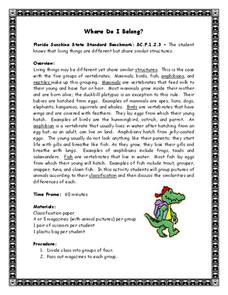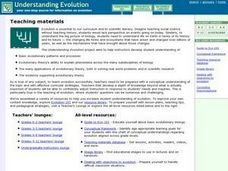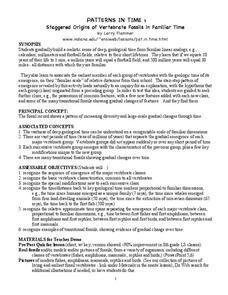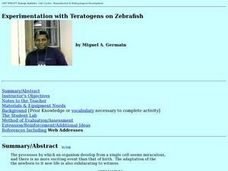Curated OER
Vertebrate History in Rocks
In this reading comprehension worksheet, students read the noted section in their science textbooks and respond to 4 short answer and 3 fill in the blank questions regarding fossils embedded in rock formations.
Curated OER
Jurassic Park Debate
Students research behavior, phsyiology, and ecology of dinoaurs. Students role-play as scientific specialists such as geneticists and ecologists. They present their research findings in a research paper.
American Museum of Natural History
The Tree of Life
Groups of species can have more in common than meets the eye. An interactive cladogram shows some of the connections between important groups of species. Learners click on sections of the diagram to learn more about the connections or on...
NOAA
Understanding Food Chains and Food Webs
Jump into an exploration of marine ecosystems with the first lesson in this four-part series. After first learning about crustaceans, mollusks, and other forms of sea life, young marine biologists view a PowerPoint presentation that...
Curated OER
Be Brain Smart
Students examine the function of the brain. Using the internet, they research facts of the brains of vertebrates. Using clay, they make three sculptures of brains of different vertebrates and use crayola colors to color it. To end the...
Curated OER
Art: Go Ahead and Bug Me!
Students research arthropods, and identify the differences between vertebrates and invertebrates. After comparing and contrasting insects and arachnids, they create drawing of them that are anatomically correct. Students place their...
Curated OER
Life Science: Living Things
Have your class build their vocabulary bank by studying life science terms. Basic terms like organism, cell, unicellular, and vertebrate are included on the definition sheet provided. Demonstrate how to identify different life science...
Curated OER
Where Do I Belong?
Fourth graders work in groups. They are given magazines. Students cut pictures of five mamals, five birds, five reptiles, five amphibians, and five fish. They place the pictures in a plastic bag. Students switch bags. They are explained...
Curated OER
Making Cladograms
Learners construct cladograms (evolutionary trees), showing how shared derived characters can be used to reveal degrees of relationship. They interpret and analyze cladograms, and determine where unclassified vertebrates would fit on a...
American Museum of Natural History
Identification Adventure
Put all the pieces together. After a skeleton is put together, pupils play the scientist to determine the type of animal they have by using a classification tree to narrow down the identity. After each decision, they gain advice from an...
Curated OER
Animals Galore
Third graders use structural characteristics to sort and classify animals into groups.
Curated OER
Dinosaur Questions
Students discuss what scientists have learned about dinosaurs. They create as a entire class a chart that has questions for "scientists" written on it. They draw pictures of what a person might look like that is searching for answers...
Curated OER
Nervous System
In this nervous system worksheet, students identify and locate each of the vocabulary terms related to the nervous system in the word search. There are 15 biology terms to locate in the puzzle.
Curated OER
The Marsh Land as a Changing Environment
Sixth graders continue their examination of the state of Connecticut. After taking a field trip, they identify the types of birds, plants, invertebrates and vertebrates who make their home in the salt marshes. In groups, they identify...
Curated OER
Adopt-An-Insect Bingo
In this biology worksheet, students select twenty-five terms relating to insects to complete their bingo card as listed on the sheet. Then they match each name or family with its correct description.
Curated OER
Patterns In Time
Seventh graders examine fossils. In this vertebrate fossils lesson students view a demonstration.
Curated OER
Experimentation with Teratogens on Zebrafish
Students compare mitosis and meiosis with regard to chromosome number in parent cells versus daughter cells, types of cells produced, total number of cells produced, and the number of divisions. In groups, identify and differentiate the...
Curated OER
Spineless - YES... Helpless - NO!
Students distinguish between invertebrate and vertebrate organisms while examining the zoological classes of a number of invertebrates. They illustrate a food web of these organisms and investigate the impact of humans on the oceanic...
Curated OER
Classification of Animals
First graders investigate the characteristics of vertebrates. They classify each as mammal, fish, bird, and reptiles. Students explore the differences between various types of animals and classify each.
Curated OER
Amphibians
Fourth graders Make flashcards for the following words, memorize them and get quizzed by the teacher: Amphibian, Lungs, complete metamorphosis, tadpoles, tail-less, tail, vertebrate, cold-blooded, gills, swamp, pond.
Curated OER
Animal Classification
Students classify animals. In this animal classification lesson, students identify characteristics from each of the 5 categories of vertebrates. Students group animals by categories.
Curated OER
Homology: Where Does The Evidence Lead
Learners are introduced to the topic of homology. In groups, they read a case study and compare different drawings of early vertebrate emryos. They work together to answer discussion questions and label the various parts of each embryo.
Curated OER
Circulatory Systems
A slideshow that covers the all-important details related to basic human circulation. The reasoning for exchange of material methods is presented and then labeled diagrams of the main human transfer systems are shown, along with...
Curated OER
EEEK! A Spider!
Youngsters complete a unit of lessons based on the story "Little Miss Muffet." They predict what will happen in the story, and use context clues to look for meaning in the words. They research information about spiders using the Internet...
Other popular searches
- Invertebrates and Vertebrates
- Life Science Vertebrates
- Five Classes of Vertebrates
- Invertebrates Vertebrates
- Vertebrates an Invertebrates
- Characteristics of Vertebrates
- Invertebrates + Vertebrates
- Biology and Vertebrates
- Vertebrates Lesson Plans
- Classify Vertebrates
- Vertebrates Lesson
- Animal Families Vertebrates

























